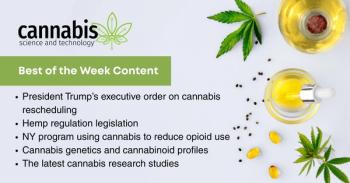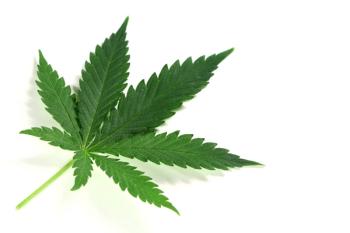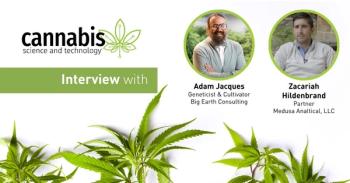
Cannabis Science and Technology
- March 2020
- Volume 3
- Issue 2
Back to the Root-The Role of Botany and Plant Physiology in Cannabis Testing, Part I: Understanding Mechanisms of Heavy Metal Uptake in Plants
Part I of this article series focuses on the physiology of heavy metal transport and translocation into and within plant tissues.
This article series will explore the effects of plant physiology on testing, including an examination of matrix effects, how specific types of analytes are transported through plant tissues, and synthesis pathways for compounds of interest such as terpenes and cannabinoids. This installment focuses on the physiology of heavy metal transport and translocation into and within plant tissues. It includes a brief explanation of the plant vascular system, how it functions, and how ions enter and move within this system. It finishes with a discussion of how nonessential, toxic substances (that is, heavy metals) enter plant systems, where they accumulate, and potential implications for testing.
Welcome to part I of the “Back to the Root” series of articles, where we will be delving into the botany of cannabis. Because all cannabis products begin with a plant, it behooves us to investigate the botanical nature of our matrix. Cannabis has proven to be a highly complex matrix and this complexity is directly tied to its botanical nature. A plant is a stationary organism; it cannot run away from threats, locate new resources when an area is depleted, or search out a mate. Instead plants use the language of chemistry to attract pollinators or herbivore predators, respond to threats with defense compounds, or direct the growth of new biomass. The goal of this article series is to help illuminate how understanding the botanical nature of cannabis is intrinsic to effective testing.
Plant Physiology
Our focus today is on heavy metal ions, particularly how they enter and move in plant tissues. When considering the movement of heavy metal ions into and throughout plant tissues, a basic understanding of plant anatomy is a prerequisite. Plants can be divided into two basic anatomical regions-the roots, consisting of everything below ground and the shoots, which is everything above ground such as the stems, leaves, and flowers.
To conduct water, essential nutrients, and the products of photosynthesis between the roots and shoots, plants have a two-part vascular system. The phloem transports photosynthates from “source to sink,” that is, it moves these compounds from where they are produced to where they are consumed. The xylem transports water and dissolved minerals from roots to shoots. While the phloem can move in both directions, the xylem is unidirectional. Another key difference between these systems is that the phloem consists of living cells that can assist in active transport, while the xylem tissue is dead at maturity and can function only via passive transport. This distinction is important because, as we will discuss in more detail later, it means that ions must be actively transported into the xylem by surrounding cells.
To maintain enough water to prevent wilting or death, plants have two primary means of facilitating the movement of water into the plant so that it can be distributed by the xylem. The most dramatic and effective means of drawing water out of the soil, which is effectively a concentrated solution, up to the top of a very tall tree is through transpiration. Transpiration is the evaporative loss of water from the shoots, which is controlled by the opening and closing of stomata, specialized pores embedded in the surface of the leaves that facilitate gas exchange. When the stomata are open, the pressure potential of the plant becomes very negative, creating a vacuum effect that draws water into the plant, moving it from roots to shoots. This flow of water into the plant and through the xylem as a result of transpiration is referred to as the transpiration stream.
The other secondary method for drawing water into the plant is by increasing the solute concentration of the roots, where most water uptake occurs. Concentration is increased by active transport of ions into the xylem from surrounding living cells, causing water to flow into and up the xylem. This phenomenon, referred to as root pressure, is most likely to occur at times when transpiration has stopped or slowed, such as at night or during times of stress, and water concentration in the soil is high.
Mineral Uptake
Now that we have some understanding of the forces that move water from soil to plant we can discuss how minerals make their way into the vascular system. Most water and mineral absorption occurs in the youngest parts of the roots. The transport of minerals into the root is thought to be an active process that is energy dependent (1). We know that the concentration of essential minerals in root tissue is significantly higher than the surrounding soil, making the concentration gradient unfavorable for passive transport. By pumping protons out of the root cells, the positive charge of the soil increases creating a gradient that drives desirable cations into the cell by means of specialized transport channels. As we will see later, these transport channels don’t exclude chemically similar ions, making them a possible entry point for heavy metals.
Once a substance enters the root, it must make its way through the root tissue to the phloem and xylem systems located in the core. There are three possible pathways that substances can utilize to travel through the root cells on their way to xylem and phloem. The apoplastic pathway travels passively along the cell wall, without entering the cell itself. Minerals cannot be transported using this pathway, although water can travel apoplastically through some of the root. Once it reaches a strip of specialized cells that serve as the gatekeepers to the xylem and phloem, it must use another pathway called the symplastic pathway. The symplastic pathway travels actively from cell to cell along a highway of cytoplasmic threads (plasmodesmata). Minerals must use this pathway because they require active transport. Once the minerals reach the inner root tissue, they are actively secreted by surrounding cells into the mature, nonliving cells of the xylem. The transmembrane pathway travels through the plasma and vacuole membranes of cells. Vacuoles are special organelles found in plant cells that are used for storage and to support the cell wall; wilting is caused by vacuoles shrinking away from the plant cell wall because there is not enough water to keep them turgid.
To recap, the movement of minerals requires two active, energy dependent steps. The first occurs during mineral uptake at the root surface, and the second when minerals are secreted into the xylem by nearby living cells. Once mineral ions have entered the xylem, they are swept up by the transpiration stream and distributed throughout the plant. Some of the ions will move laterally throughout the roots and stems, while others will continue on to the leaves. Some ions remain in the transpiration stream and are delivered to the leaves where they escape into the atmosphere through the stomata. However, most ions will be actively transferred to the phloem in the leaves, entering the assimilation stream. From the assimilation stream they can be transferred to the youngest parts of the plant or to reproductive organs, such as the flower of a cannabis plant. Interestingly, there is no direct exchange between flowers or young shoots and the xylem; the phloem always acts as an intermediary.
Heavy Metal Uptake
With the physiological transport of water and mineral ions throughout plant tissues in mind, we can talk more specifically about heavy metal uptake, which refers to the movement of ions from the soil into the plant. This discussion will focus on arsenic, lead, cadmium, and chromium because they have been well researched from a plant-physiology perspective. Plant heavy metal uptake is dependent on several factors that affect metal availability and mobility, such as the chemical form and speciation of the metal, soil pH, and soil composition. Furthermore, these variables directly impact each other and therefore cannot be viewed independently.
Take arsenic for example. The speciation of arsenic directly determines its bioavailability; as As(III) it is much less mobile in the soil, and thus less bioavailable than As(V) which has greater soil mobility (2). Soil pH also impacts the chemical form of arsenic in the soil and thus its bioavailability. Low soil pH (pH <4) tends to increase plant uptake of arsenic by enhancing its ability to complex with iron (2). Soil composition plays a role as well, since the presence of either manganese or iron oxides will increase arsenic uptake (2). So, a combination of low soil pH and high iron content together will increase the bioavailability of arsenic. Once a heavy metal makes it close enough to a root cell for plant uptake it enters via the symplastic pathway. Heavy metals often enter plant tissues via the same mechanisms through which desirable, essential minerals such as nitrogen or phosphorous are acquired. Arsenic generally enters plant tissues as As(V), through phosphate transport channels (2). This means that it competes with phosphate for root uptake because of their chemical similarities.
The speciation of chromium, pH of the soil, and soil composition all impact its bioavailability. Chromium enters the roots symplastically, as either Cr(III) or Cr(VI) (2). A pH greater than 5 can decrease Cr(III) solubility by increasing the formation of chromium oxide Cr(OH)3 (3). On the other hand a pH below 5 can decrease the mobility, and thus plant uptake, of Cr(III) because it results in greater adsorption of Cr(III) to clays and oxide minerals in the soil (3). This effect is highly dependent on soil composition; specifically, it is seen in soils with high clay or metal oxide content. So here again we can see that pH in conjunction with soil composition has a combined effect on chromium bioavailability. Chromium enters plant tissues by undergoing reduction, complexation with root exudates, or a combination of the two (2).
For cadmium, uptake is primarily impacted by the presence and concentration of specific minerals in the soil. Manganese enrichment of the soil can increase cadmium uptake while high iron levels will decrease it (2). Furthermore, lowering the pH of the soil appears to increase cadmium uptake by causing the chelation of cadmium with iron (2). This tends to occur when there is an iron deficiency that causes the plant to secrete organic acids into the soil in an attempt to increase iron uptake (2). This suggests that cadmium enters plants through the cellular mechanism that facilitates iron uptake. We do know with certainty that cadmium enters plant cells by flowing down the electrochemical gradient used to drive the cations of essential minerals into the plant cell (2).
Overall, lead has a low solubility and is not readily bioavailable to plants (2). It tends to form complexes with phosphates and sulfates, which are commonly found in the root zone since they are essential to plant nutrition (2). It seems that soil composition is the most important factor for the uptake of lead and that nutrient depleted soils are likely to have greater instance of lead uptake in plants. How lead enters plant cells is still unknown; there are no natural channels for lead uptake, but lead can and does bind to the carboxylic groups of the uronic acid mucilage that coats the surface of the root, protecting it from soil abrasion (2). For this reason, lead is more commonly found as a contaminant in root crops, potentially in greater quantities on the surface of the root rather than within plant tissues.
Heavy Metal Testing and Research
Because there are so many variables that can impact heavy metal uptake, research that seeks to address issues of heavy metal contamination in cannabis will be necessarily complex. When attempting to troubleshoot contamination it will be important to have an understanding of the metal speciation and form in the contaminated soil. Depending on the metal contaminant, measurement of soil pH could prove useful for elucidating enhanced metal mobility and thus uptake by plants. Determination of soil composition, because it also can directly impact mobility and uptake, might prove useful as well. Unfortunately, to diagnose and correct metal contamination, it is likely that each of these variables would need to be explored. This process could be further complicated depending on the conditions of the farm itself. Indoor farms range from relatively to highly controlled environments, while outdoor farms are open systems that essentially equate to field research.
Once a heavy metal enters a plant, several things can happen: metals can be sequestered in root cell vacuoles or walls, biotransformed to less toxic molecules, or transported from the roots to the shoots (translocation) (2,4). Remember that in the case of minerals, translocation occurs primarily in the xylem for roots and stems, but minerals are transferred to the phloem to reach the flowers and youngest shoots. Which of these options occurs is plant species dependent. Because there is little research on heavy metal uptake in cannabis, what happens after metal uptake occurs in cannabis plants is not well understood.
The following information comes primarily from agricultural and phytoremediation research, which is extensive, with the goal of giving the reader some idea of how these metals might behave in cannabis plants. In general, there are three groups that plant species can fall into for each respective metal. Some species are able to sequester significant concentrations of toxic metals in root tissues, before increased soil concentration forces translocation to avoid poisoning (2). Other species are more likely to translocate metals to aerial tissues and still others can maintain equilibrium with external metal levels in their shoots and roots until toxicity occurs (2). Further, since each metal has unique chemical properties they often behave differently within plant tissues.
Once arsenic has entered plant tissues in the form of As(V), it is often reduced to As(III) or biotransformed into a less toxic compound (2). Some of these compounds include dimethylacetamide (DMA), methyl methacylate (MMA), or inorganic As(III) that has been complexed with thiol groups (2). We know that plants can synthesize enough arsenic reductase because of experiments that showed that both species of arsenic were present in plant roots, but only As(III) was found in the plant’s shoots (2). Research has also shown that plants grown in As(III) amended soil will still uptake a percentage of the arsenic after oxidizing it to As(V).
While it is possible for chromium to be translocated, most chromium is sequestered in the vacuole or cell wall of root cells (2). However, it has been shown that chromium mobility within the plant is dependent on its chemical form (2). As mentioned earlier, chromium uptake sometimes involves complexation with root exudates, many of which are also organic acids. Complexation with these organic acids increases chromium solubility, making it more mobile in the root xylem (2).
Cadmium can be stored in the vacuoles of root cells by phytochelatins that act as chelators to bind cadmium, restricting its movement through the root (2). If cadmium is not bound it can move unrestricted through the root in some plant species via a low-affinity calcium transporter. Translocation can occur in this case, but an unknown mechanism controls and regulates translocation to the aerial shoots (2). Certain plants that can accumulate high concentrations of cadmium are detoxifying it by complexing cadmium with low molecular weight thiols (2).
Some plant species can detoxify lead by complexation or inactivation and the roots appear to be the primary place where lead is found (2). Lead can be bound to plant cell walls at ion exchange sites, but unbound lead will move towards the root core via calcium transport channels until it reaches a strip of specialized cells called the Casparian strip (2). The Casparian strip can act as a lead barrier to the vascular system at lower concentrations (2).
This hopefully provides a general appreciation for the many ways that specific heavy metals behave once they are in plant tissues. Some overarching patterns include root sequestration, detoxification through biotransformation, or translocation.
Cannabis and Heavy Metal Research
While there is much research into heavy metal uptake, accumulation, and translocation in edible crop species for obvious consumer safety reasons, much less is known about heavy metal uptake in members of the genus Cannabis. What research has been done has focused primarily on low cannabidiol (CBD) varietals, commonly referred to as “hemp,” with little to no research available on the high tetrahydrocannabinol (THC) varietals mainly found in recreational and medical markets. While there is still much debate on how to botanically classify the various species in the genus Cannabis and indeed exactly how many species exist, research on both high CBD and THC chemotypes is critical.
Based on what research there is, hemp (Cannabis sativa) is thought to be an excellent candidate for phytoremediation of heavy metal contaminated soils (4). Some work was done on the phytoremediation potential of hemp around the Chernobyl site in 1998 that had promising results, and an abstract from the International Botanical Congress of 1999 indicated that C. sativa can accumulate lead and uranium in aerial parts (4). More recently, researchers have explored how effectively hemp is at accumulating chromium, cadmium, and nickel. The researchers also investigated metal translocation to the stems and leaves by comparing the concentration of metals in the roots, stems, and leaves of plants grown in soils with different heavy metal concentrations.
Interestingly, Citterio and colleagues found that hemp predominantly accumulates these heavy metals in its roots (4). This has serious implications if whole-plant testing becomes standard practice in heavy metal analysis for hemp. The researchers also investigated if heavy metals had any impact on hemp plant growth. They found that at experimentally elevated levels (Cd 80 µg/g, Ni 115 µg/g, and Cr 140 µg/g), heavy metals in the soil do not significantly interfere with hemp growth (4). However, there were measurable stress responses, such as elevated levels of phytochelatins and glutathione as well as the production of a novel phytochelatin in treated plants (4).
Further evidence that hemp plants sequester heavy metals in their roots was found in a study by Linger and colleagues that looked at the uptake and impact of cadmium on growth and photosynthesis in hemp (C. sativa). Researchers found that up to 17 mg/kg of available cadmium can be tolerated by hemp plants without any major effects to biomass production (5). They found at values near 72 mg/kg that cadmium began to have a significant impact on plant growth and photosynthesis. Both studies used a fiber variety of hemp, but Linger and colleagues had a lower soil pH while Citterio and colleagues had a soil pH that was slightly basic, which could have contributed to greater cadmium uptake into plant tissues at comparable cadmium soil concentrations.
Conclusion
Our understanding of how the genus Cannabis uptakes, translocates, or sequesters heavy metals is still on the scientific frontier. Research on other heavy metals of interest such as mercury, lead, and arsenic is still needed. It would also be useful to determine the mechanisms through which Cannabis species uptake, sequester, and control the translocation of different heavy metals since much of this information is speculated based on other plant species, namely agricultural crops or model organisms. Finally, it is important that chemotype (high CBD, high THC, fiber producing, and so on) be treated as an important variable, with studies done on different varietals. We still do not have a clear picture as to how to classify the different members of the genus Cannabis, so we cannot assume that different chemotypes will respond to the same external factors in the same way.
In the next installment we will explore pesticides, and how they interact with pre-existing plant defense systems.
References:
- R.F. Evert and S.E. Eichhorn, Raven Biology of Plants, 8th Edition (W. H. Freeman, Macmillan, 2013) pp. 708–721.
- J.R. Peralta-Videa, M.L. Lopez, M. Narayan, G. Saupe, and J. Gardea-Torresdey, Int. J. Biochem. Cell Biol.41(8–9), 1665–1677 (2009).
- R.A. Wuana and F.E. Okieimen, ISRN Ecol, A 402647, 1–20 (2011).
- S. Citterio, A. Santagostino, P. Fumagalli, N. Prato, P. Ranalli, and S. Sgorbati, Plant Soil, A 256, 243–252 (2003).
- P. Linger, A. Ostwald, and J. Haensler, Biol. Plant. A 4, 567–576 (2005).
About the Author
Gwen Bode, B.S., is an aspiring doctoral candidate and botanist with a strong chemistry background. As an undergraduate at Eastern Washington University she investigated the vitamin content of a wild edible plant via HPLC. She has since worked at the front line of the cannabis testing industry, integrating her botanical knowledge with the practical aspects of analytical testing. Direct correspondance to:
How to Cite this Article
G. Bode, Cannabis Science and Technology3(2), 26–29, 45 (2020).
Articles in this issue
almost 6 years ago
Are There Limits to the Range of Possible Cannabinoid Ratios in Plants?almost 6 years ago
Cannabis Laboratory Testing Market in North Americaalmost 6 years ago
Low Oxygen: A New Method for Cannabis CultivationNewsletter
Unlock the latest breakthroughs in cannabis science—subscribe now to get expert insights, research, and industry updates delivered to your inbox.



